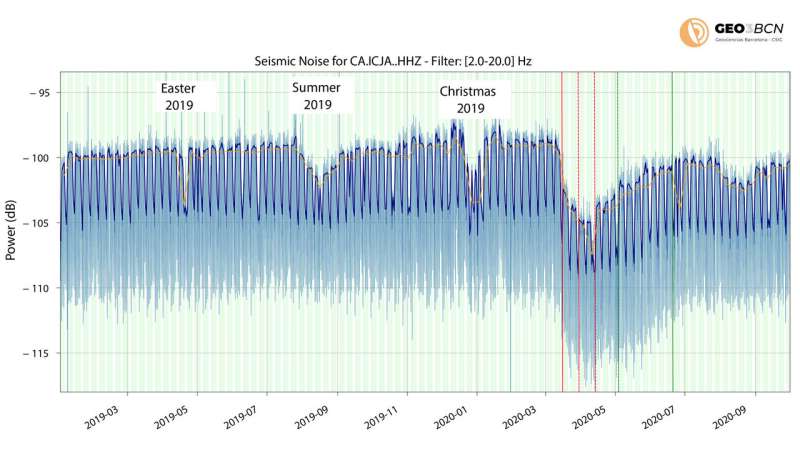Seismic data might be a useful indicator of human activity in cities, study suggests

Seismic data could be used under certain conditions as a proxy to monitor the level of human activity in urban environments, providing similar details to those offered by other common mobility indicators, according to a new study made by researchers from Geosciences Barcelona—CSIC. Seismologist Jordi Díaz is the leading author of the study that has been published recently in the journal Solid Earth. Mario Ruiz and José Antonio Jara, the from Institut Cartográfic i Geologic de Catalunya (ICGC) are the other authors of the study.
The authors conducted a detailed analysis of the background seismic vibrations ("seismic noise") variations recorded by a temporal dense seismic network deployed in Barcelona, active from September 2019 to September 2020. The analysis allowed researchers to distinguish the different phases and human activity patterns during the quieting associated with the COVID-19 lockdown in a similar way to other mobility indicators, such as data provided by large communication companies.
The SANIMS project temporary array recorded the seismic noise variations in Barcelona associated with the lockdown measures to mitigate coronavirus outbreak between 13th March and 21th June. These seismic noise variations are related to the lockdown restrictions and the reduction of the vibrations generated by traffic and industrial activity.
Researchers note that seismic data have some important advantages when compared with other mobility indicators since they are open and "its availability does not depend on the decisions of private companies." Moreover, the authors highlight that traffic and industrial activity are aggregated in the seismic data. They also stress that the installation and maintenance of the sensors is easy and note the existence of a well-established protocol to share data in real-time.
The network consisted of 19 seismic sensors distributed with a spacing of 2-3 km. 14 of those seismometers were installed in the facilities of secondary schools that collaborated with SANIMS project. The objective of the project was to acquire data of scientific interest in urban environments, but also to promote knowledge about seismology and Earth Sciences among high school students. "The network covered a wide area of the city of Barcelona," said Jordi Díaz, who added that "having a dense seismic network allowed us to detect the differences of the signal registered in every location and to obtain a mean value to get an insight of what was happening in the city." Data recorded by five permanent stations from the ICGC was also used in this study.
Researchers processed the acquired data and focused their analysis on the seismic vibration in the 2-20 Hz band, mostly generated by traffic, industrial and construction activities.
"Our study shows that the reduction of human activity in Barcelona during the lockdown had a direct impact on the seismic vibration levels," said Jordi Díaz. The study confirms that quieting of human activity during lockdown has resulted in a reduction of seismic vibrations generated by human activities like traffic or industrial activity higher than during holiday seasons.
To verify the validity of the recorded data, researchers compared seismic data with other mobility indicators provided exceptionally by companies like Google, Apple, or Facebook during the lockdown based on mobile phone activity. They also inspected data provided by the Barcelona transport authority regarding the number of validations of trips in bus, metro, and tramway, and other mobility datasets provided by the Spanish Institute of Statistics (INE) based on the information provided by the three main mobile phone operators.
"The variations in seismic power over time make it possible to distinguish the different phases of lockdown, at least in a similar way to other mobility indicators," researchers wrote.
On the other hand, the drop of seismic noise levels in Barcelona during the lockdown is similar to other cities all over the world as reported in a recent study published in Science, also co-authored by Díaz. "The effect on the seismic noise levels is similar on a global scale, but in Barcelona, we have been able to analyze the registered variations in different locations more precisely thanks to our temporary seismic array."
Researchers also highlight the value of the seismic network deployed by SANIMS project for the dissemination of Earth Sciences in secondary schools, since it can develop student's interest not only in seismology but to promote the use of scientific methodologies. Researchers recall that collaboration with educational centers has led to three high school research projects based on the analysis of seismic data.
More information: Jordi Diaz et al. Seismic monitoring of urban activity in Barcelona during the COVID-19 lockdown, Solid Earth (2021). DOI: 10.5194/se-12-725-2021
Journal information: Science
Provided by Geosciences Barcelona




















